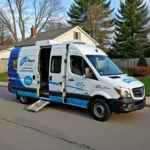Power windows are a modern convenience many of us take for granted – until they stop working. A malfunctioning power window can be a frustrating experience, leaving you with a window stuck open or closed. This comprehensive guide delves into the common causes of power window problems, the intricacies of repair, and essential tips to keep your windows rolling smoothly.
Understanding the Mechanics of Your Car’s Power Windows
Before we dive into troubleshooting and repair, it’s helpful to understand the basic components of a power window system:
- Window Motor: This electric motor provides the power to raise and lower the window.
- Window Regulator: The regulator is a mechanical assembly, often utilizing cables or a scissor-like mechanism, that physically moves the window up and down.
- Switches: The buttons or levers on your door panel send electrical signals to the motor, controlling window movement.
- Wiring and Electrical Components: A network of wires and relays transmit power and signals throughout the system.
Common Car Power Window Problems and Their Causes
A range of issues can affect your car’s power windows. Here are some of the most frequent culprits:
- Faulty Window Motor: A worn-out motor is a common cause of power window failure. You might hear a grinding noise if the motor is struggling.
- Broken Window Regulator: Wear and tear, especially on the cables or plastic components of the regulator, can lead to malfunction.
- Bad Window Switch: A faulty switch can disrupt the electrical signal, preventing the window from operating.
- Blown Fuse: A power surge or short circuit can blow the fuse dedicated to the power windows.
- Wiring Issues: Damaged or corroded wires can disrupt the flow of electricity to the motor or switch.
Diagnosing Power Window Issues
Determining the root cause of your power window problem often requires a bit of detective work. Here’s a step-by-step approach:
- Listen Carefully: When you activate the window switch, listen for any unusual noises. Grinding or clicking sounds can indicate a motor or regulator issue.
- Check the Switch: Swap the suspected faulty switch with a working switch from another door. If the problem moves to the other door, the switch is likely the culprit.
- Inspect the Fuse: Locate the power window fuse in your car’s fuse box (consult your owner’s manual). Check for a blown fuse indicated by a broken wire inside.
- Visual Inspection: If comfortable, carefully remove the door panel to visually inspect the motor, regulator, and wiring for any visible damage.
Car Power Windows Repair: DIY vs. Professional
power-windows-repair-cars often involves working with electrical components and disassembling door panels. While some car enthusiasts may have the skills and comfort to tackle this repair themselves, it’s often best to seek professional assistance.
A qualified mechanic has the expertise, tools, and experience to diagnose and repair power window problems accurately and efficiently.
“Attempting a complex car repair like this without proper knowledge can lead to further damage and costlier repairs down the line,” warns master mechanic John Smith of Smith’s Auto Repair. “It’s always best to err on the side of caution and consult a professional.”
Tips for Preventing Power Window Problems
- Regular Cleaning: Keep the window tracks free from dirt, debris, and lubrication buildup.
- Avoid Forcing: Never force a window to move past its limits.
- Address Issues Promptly: Don’t ignore any unusual noises or sluggish window operation.
Conclusion
Car power windows repair can range from a simple fuse replacement to a more involved motor or regulator repair. Understanding the common causes, knowing how to diagnose problems, and seeking professional help when needed will keep your windows operating smoothly for miles to come.


